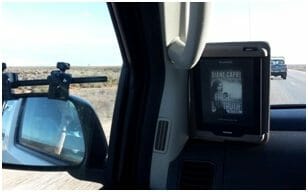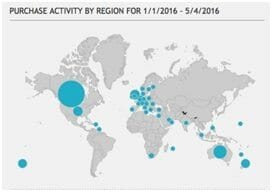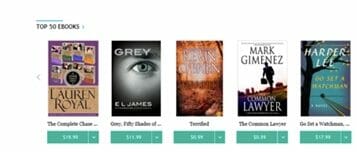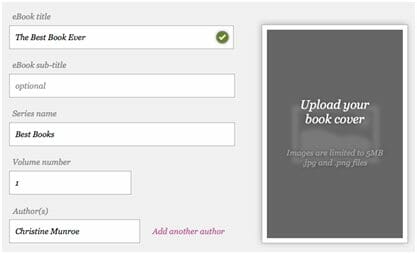by Christine Munroe (@munroechristine)
Many authors have been asking me about distribution for their ebooks, and how to reach more markets. Luckily, while I was at the recent IBPA Publishing University in Salt Lake City, I had the chance to meet Christine Munroe, the U.S. manager for Kobo. (Kobo is a Canadian company which sells e-books and e-readers. The name Kobo is an anagram of book.) I asked Christine to tell us how Kobo empowers indie authors to sell their books globally. Here’s her response.
Why should self-published authors and small publishers distribute directly to Kobo? And how can you grow your global sales? Here are detailed tips on maximizing your potential with the Kobo Writing Life (KWL) platform, featuring advice from some of our current bestselling authors.
What is Kobo Writing Life?
KWL is a free self-publishing platform that helps authors publish their eBooks to Kobo customers in over 190 countries. Our royalty structure is 70% for books priced $2.99 USD and higher (no price cap), and 45% for books under $2.99. You can price your books free anytime. It’s a simple four-step process to upload your eBook, then you can track global sales live in the dashboard and get paid in the currency of your choice. Some other features include the ability to set up pre-orders and a price scheduling tool that helps you set a promo price in advance.
We’re part of Rakuten Kobo Inc., a Toronto-based, Japanese-owned company dedicated completely to eReading. Unlike other retailers, Kobo doesn’t sell other products; we focus on helping readers discover the best eBooks from our library of 5 million titles, and read on one of our dedicated Kobo eReaders or on any device with the free Kobo app.
What Our Merchandisers Look For
-
Professionalism
You absolutely must hire a professional editor and cover designer in order to stand out among the 5 million+ eBooks available on Kobo. Think about the cover’s thumbnail version – can you still read the title and author name? Keep the font large and other elements simple.
-
Clean metadata
Enter accurate and consistent information in each field when you upload your books. Use the exact same “Series Name” and correct series number to help our system drive sales across your series (if you don’t, we can’t automatically link them on kobo.com). Pick accurate and specific categories for your eBook to achieve a high ranking – we let you choose three per book. For example, opt for “Mystery & Suspense, Thrillers” instead of the broad “Fiction & Literature”. Ask your editor to review your synopsis; this all-important content needs to be catchy and error-free.

Use metadata fields like “Series Name” and “Volume Number” accurately to improve your searchability on kobo.com -
A decent price
As a broad benchmark, the majority of our successful indie authors price full-length novels between $3.99-$5.99 USD. Experimenting with a higher price point opens up discounting opportunities for appealing temporary price drops. Since Kobo is so globally focused, you should take advantage of our manual price conversion tool for all of your eBooks, instead of relying on an automatic price conversion (find this in Step 4 of the dashboard – “Set the Price”). Some specific advice: round to the nearest .99 for all English-language countries; to the nearest .49 or .99 for GBP or Euros. For example, it looks very awkward and unprofessional for a customer in Canada, Kobo’s home turf and our largest market, to see a book at the auto-converted price of $5.06 CAD, instead of $4.99. You can also price differently for each market; Canada and Australia, for example, are not as price-sensitive as the US and the UK, so you can try higher or lower prices per country to find your sweet spot.
Your Books Are Live on Kobo. Now What?
- Invest time and marketing budget into targeting each retailer specifically. Cristin Harber made a concerted effort to build her Kobo sales last year, and saw her sales double. She explains,
“Try to customize your interaction with readers by retailer. Don’t do a boosted Facebook post with all of the retailers listed in a row. Rather, have individual posts where you can target by device-user, operating system, by country, etc. Take time to figure out what each retailer offers a reader and why someone might buy a book from one store over another. After you know that, you have a way to target them.”
- Create a distribution plan, and stick with it. Growing a customer base at a retailer takes time and dedication. Pulling titles in and out of a retailer will only frustrate readers and hurt your sales, forcing you to essentially start over when you relist them.
- Treat retailers as business partners. Learn about each retailer and the opportunities they can offer you. Attend conferences, meet the retailer representatives, and form a relationship. Contact us if you have questions, and keep us in the loop with new releases and upcoming promotions. We love hearing from authors and collaborating to help you sell well.
- Think Global. The book retail landscape looks different in every country, and you could be reaching readers around the world – even without books in translation. Diane Capri first uploaded to KWL in 2012, and has seen her sales grow from just 20 books in the first month, to breaking into our top 10 bestselling KWL authors in 2015. She notes,
“With the rising popularity of e-reading on tablets and phones, I thought readers could find my books and read them from anywhere, regardless of which retailers were selling. But I’ve learned that readers are intensely loyal to their favorite retailer and to reach millions of Kobo readers, I needed a Kobo presence. Kobo has greatly expanded my global reach and Kobo readership has grown rapidly from a modest start three years ago. Now, my Kobo readers are among the most devoted readers I have.”
 |
 |
A Golden Age of Options, and Difficult Decisions
It used to be that a publisher’s yes-or-no answer to your manuscript meant the difference between launching or ending a writer’s career. Now, authors can completely control their business—but with this opportunity comes the responsibility to run the entrepreneurial side of publishing, and make decisions based on your goals.
One major decision indie authors face now is whether to publish exclusively to one retailer. It’s quite obviously in our best interest to give the short answer: absolutely not. We want all of the great books to be available everywhere. We want a healthy, competitive market – one which lets readers read how and where they want to, keeps author royalties high, and forces us as retailers to remain innovative. As indie authors calling the shots by providing your content and driving your fans to retailers, you hold the power to keep the bookselling market diverse.
Cristin notes,
“I’m not comfortable relying on one distributor. Things change. The market can shift. I plan to be here in twenty plus years selling great books, and I don’t know about other companies’ business plans. I assume they will, too. But I don’t know. Nor do I know how their royalty plans will be structured or what their buyers will want. My long term plan takes into account that unknown. I want a diversified portfolio. I want strong legs at all retailers so that if I have a bad month at one place, I’m not hurting. If a corporate policy changes, I can roll with the punches.”
What’s Selling Well Right Now at Kobo
Fantasy author Lindsay Buroker’s Kobo sales grew 200% from 2014 to 2015. What’s her strategy?
“It’s old advice you’ve probably heard before, but I’m still getting a lot of mileage out of writing in a series, having the first one free, and then promoting that free book.”
This is true for many of our top sellers, and First Free is a strategy we recommend as a discovery tool for authors with many books available. Kobo has a dedicated, curated Free page where we mostly highlight first free in a series titles.
On the other end of the pricing spectrum, we have no price cap on our 70% royalty, so many authors are finding success with big boxed sets priced at $10 and up to bring in a new niche of readers who want to buy the whole series at once. Lauren Royal hit #1 on Kobo – beating out GREY and GO SET A WATCHMAN – with a $20 boxed set, THE COMPLETE CHASE FAMILY SERIES.

Books in foreign languages continue to be a growing market at Kobo. Philippe Saimbert is one of our bestselling French authors, and he hit #1 in France recently – with a book that was originally published in 2013. Our European KWL Manager Camille Mofidi explains that Philippe is a great example of working collaboratively with the KWL team; he’s been with KWL since the beginning and we continue to promote his titles in France and Quebec.

Resources
KWL platform login: www.kobo.com/writinglife
Blog and Podcast: www.kobowritinglife.com
Contact us: [email protected]
 Christine Munroe is the US Manager for Kobo Writing Life, where she helps authors, agents, and small publishers reach readers in over 190 countries. She also contributes to KWL’s blog and podcast, free resources for Kobo’s indie community. She brings to Kobo years of experience as a foreign book scout and literary agent.
Christine Munroe is the US Manager for Kobo Writing Life, where she helps authors, agents, and small publishers reach readers in over 190 countries. She also contributes to KWL’s blog and podcast, free resources for Kobo’s indie community. She brings to Kobo years of experience as a foreign book scout and literary agent.




